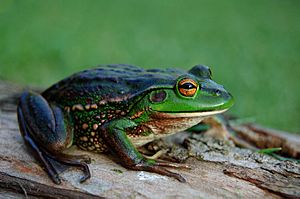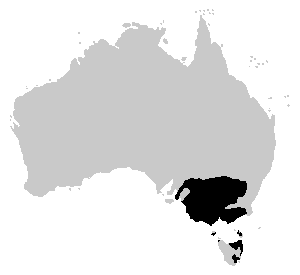Growling grass frog facts for kids
The growling grass frog, also known as the green and gold frog or southern bell frog, is a type of tree frog found in Australia. You can find it in places like South Australia, New South Wales, Victoria, and Tasmania. It has also made its way to New Zealand, where it is considered an invasive species, meaning it's not native and can cause problems for the local environment.
These frogs are often spotted sitting on plants close to water, like ponds or dams, especially in places where the water doesn't dry up. They sometimes hide under logs to stay safe. Their life cycle is interesting: some tadpoles turn into frogs in the autumn, while others stay as tadpoles through the winter and only become frogs in the spring!
Sadly, the growling grass frog is an endangered species. Scientists are working hard to understand why. Some ideas include increased ultraviolet (UV) radiation from the sun, which can harm them. Also, invasive species like the eastern mosquitofish can eat their eggs and young tadpoles. Another big threat is a serious fungal disease called chytridiomycosis, which affects many amphibians around the world.
Quick facts for kids Growling grass frog |
|
|---|---|
 |
|
| Conservation status | |
| Scientific classification | |
 |
|
| Synonyms | |
|
Contents
What Does It Look Like?
The growling grass frog is a medium to large frog, usually growing to about 5 to 10 centimeters long. It has a striking appearance, with a bright green back that often has golden or bronze markings. These markings can look like spots or stripes. Its belly is usually white or cream-colored.
One of its cool features is its skin, which can be smooth or a bit warty. It has a distinct stripe that runs from behind its eye down to its shoulder. The inside of its thighs can be a bright blue or green, which is why it's sometimes called the "blue-thighed tree frog." Its eyes are golden with horizontal pupils.
Where Does It Live?
This frog loves to live near water. You'll find it in wetlands, swamps, slow-moving streams, and ponds. It especially likes places with lots of plants growing in and around the water, like reeds and rushes. These plants provide good places to hide from predators and to hunt for food.
They prefer water bodies that are permanent and don't dry out, as this is important for their life cycle and for their tadpoles to grow. While they are called "tree frogs," they spend a lot of time on the ground or in low-growing plants near water, rather than high up in trees.
What Does It Eat?
The growling grass frog is a carnivore, which means it eats other animals. It's a skilled hunter and will eat a variety of small creatures. Its diet mainly includes insects like crickets, moths, and beetles. It also preys on other invertebrates such as spiders and worms.
Sometimes, larger growling grass frogs might even eat smaller frogs or tadpoles. They use their long, sticky tongues to catch their prey quickly. They usually hunt at night, waiting for unsuspecting insects to come close.
Life Cycle and Reproduction
The reproduction of the growling grass frog usually happens in the warmer months, from spring through summer. Male frogs make a loud, "growling" call to attract females, which is how they got their name. This call sounds a bit like a motor or a distant growl.
After mating, the female frog lays her eggs in the water. These eggs are usually laid in large clumps, often attached to underwater plants. A single female can lay thousands of eggs!
The eggs hatch into tadpoles. These tadpoles are aquatic, meaning they live entirely in the water. They feed on algae and other tiny plant matter. Tadpoles go through a process called metamorphosis, where they gradually change into frogs. They grow legs, their tails shrink, and they develop lungs to breathe air. This process can take several months, and as mentioned earlier, some tadpoles might even spend the winter as tadpoles before completing their transformation in the spring.
Threats and Conservation
The growling grass frog faces several serious threats that have led to its endangered status:
- Habitat Loss: Many of the wetlands and ponds where these frogs live are being destroyed or changed by human activities like building, farming, and draining land. This leaves the frogs with fewer places to live and breed.
- Water Quality: Pollution from chemicals and fertilizers can harm the frogs and their tadpoles, making their water unsafe.
- Disease: The chytrid fungus is a major problem. This fungus infects the skin of frogs and can make it hard for them to breathe and absorb water, often leading to death.
- Introduced Species: Animals brought in from other parts of the world, like the eastern mosquitofish, can eat the frog's eggs and tadpoles. Other introduced predators, like foxes and cats, can also hunt adult frogs.
- Climate Change: Changes in weather patterns, including droughts and more intense UV radiation, can also negatively impact the frogs and their habitats.
Conservation efforts are underway to protect the growling grass frog. These include protecting and restoring their wetland habitats, controlling invasive species, and researching ways to combat the chytrid fungus. It's important to keep their habitats healthy so these unique frogs can survive and thrive.
Images for kids
See also
 In Spanish: Litoria raniformis para niños
In Spanish: Litoria raniformis para niños



